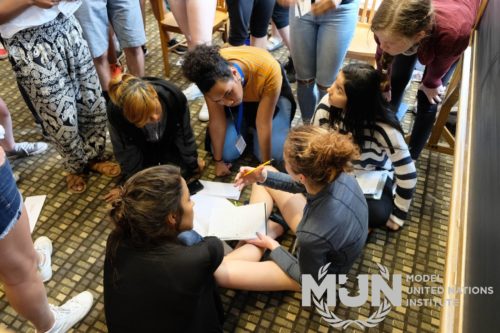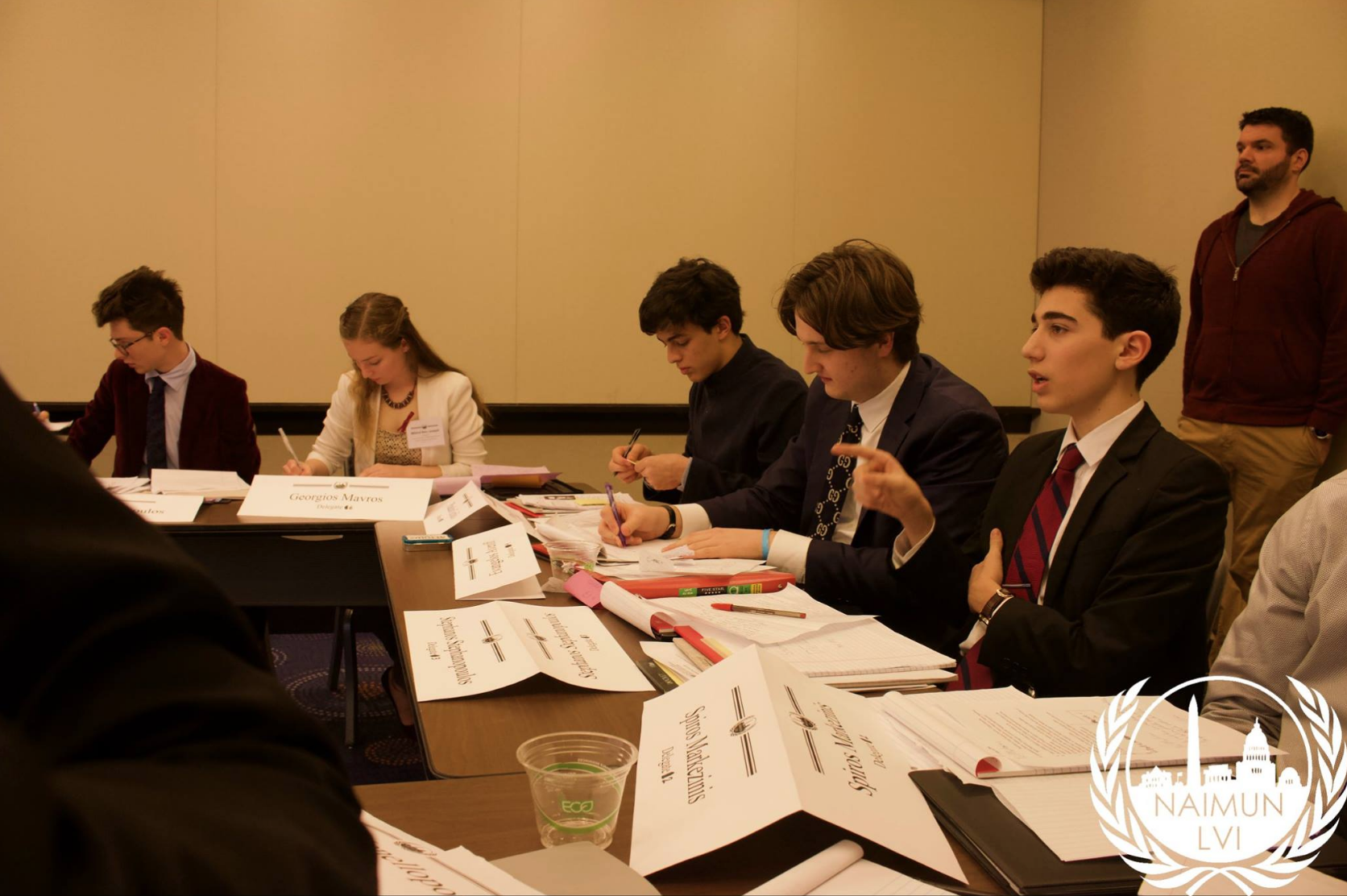
The following article is written by Khai Nguyen, a Best Delegate Media Associate and Director-General of CHMUN XIV.
From January 11-12, 2019, the fourteenth iteration of the Chantilly Model United Nations Conference (CHMUN XIV), hosted by Chantilly High School Model United Nations, successfully highlighted the principles that Model UN celebrates through the attending delegates’ comprehensive debate and insightful resolutions. This year, the conference saw among the most talented delegates in the high school Model UN circuit, welcoming over 750 delegates from 35 schools around the national capital.
With the conference showcasing a theme of personal growth and development, this iteration of CHMUN opened with individual speeches from Secretary-General Priya Viswanathan, Under-Secretary-General Prithvi Kinariwala, and Director-General Khai Nguyen, who each shared a story pertaining to their personal growth as middle school delegates to now organizing one of the largest high school conferences on the East Coast. The conference then welcomed keynote speaker, Mr. Mark Giaconia, who served as an Army Green Beret in Bosnia, Kosovo, Kyrgyzstan, and Iraq for 15 years, and now holds two awards for valor from combat actions in Kosovo and Iraq. In addition to sharing his experiences while deployed, Mr. Giaconia also encouraged delegates to take this opportunity and strive for personal development in becoming more detail oriented, collaborative, and confident as they have been among the most important qualities required throughout his career.

Director-General Khai Nguyen, declaring CHMUN XIV in session!

Delegates moving into voting procedure in the Antarctic Treaty Consultative Meeting (ATCM)
After the conference was gaveled into session, each of the delegates reported to their respective committee rooms. This iteration of CHMUN featured twenty committees, each chaired by a Chantilly MUN Alumni to elevate both the quality of chairing and the delegates’ experiences as they debated the critical issues facing the international community. CHMUN has long since pride itself on having a diverse committee roster, spanning past the generic General Assemblies seen at nearly every conference. With committees ranging from the Antarctic Treaty Consultative Meeting (ATCM) to King Arthur’s Roundtable or the Senate Committee on the Judiciary to the World Cyber Security Congress, it was the goal of the Secretariat to offer topics that ranged from historical to scientific and aim to expand debate across the past, present, and future and across all disciplines, encouraging delegates to develop new alliances in pursuit of a common goal and to resolve pressing global issues. Most importantly, however, beyond the competitive nature of the diverse committees, delegates were challenged to question common beliefs and reach beyond their comfort zone, placing diplomacy and inclusivity above all else.
In addition to priding itself on its committee line up, the main component that came to define this iteration of CHMUN, and hopefully those in the future, is its automation programs. Authored by Director-General Khai Nguyen, over 3,000 lines of code were integral to the success and efficiency of CHMUN XIV, and further elevated the experiences of delegates and their sponsors. One of these programs include a registration algorithm that was able to optimize position assignments, for each delegation to receive at least one of their requested country preference, eliminating human error, bias, and favoritism towards schools. This algorithm, paired with a program that generates payment invoices, was able to distribute position assignments and payment invoices within the hour of a delegation’s registration. Additionally, in order to remain punctual, despite having to condense the conference itinerary due to the inclement of weather, an awards program was able to instantaneously format and print awards, and calculate delegation awards in the process, ensuring that Closing Ceremonies start as scheduled. These programs, alongside others not mentioned, have come to define the punctuality and efficiency of CHMUN XIV.

JCC: LA Turf Wars – Crips Committee Chair, Misran Dolan delivering a crisis update.
Aside from the aforementioned programs, the backbone of the conference lies with its staffers who have spent months in preparation for CHMUN XIV. In particular, the Crisis Department, responsible for addressing all components of Crisis Committees, exceeded expectations through their integration of unique components that push the boundaries of a Crisis Committee. Their usage of technology for updates in the creation of videos and use of Twitter, elaborate assassination skits, inclusion of war simulations, and committee face offs between Joint Crisis Committees, ensured that committee sessions were constantly pushed forward with crisis updates, while maintaining a light and fun atmosphere.
Alongside providing experiences for attending delegates, the Secretariat additionally worked in order to ensure the livelihood of sponsors. In addition to providing food and refreshments, coordinated by the Hospitality Department, the CHMUN XIV Secretariat welcomed Best Delegate’s very own Mr. Aaron Kalafarski to run an Adviser Workshop that was attended by both veteran advisers and those wishing to expand their new delegations’ MUN programs.

Delegation awards presented at CHMUN XIV.
After a long year of hard work and preparation, the CHMUN XIV Secretariat would like to thank all CHMUN XIV Staffers, Keynote Speaker: Mr. Mark Giaconia, Adviser Workshop Director: Mr. Aaron Kalafarski, and all attending delegates and sponsors who have made CHMUN XIV a reality. With that, the Chantilly MUN organization looks forward to another successful conference in January of 2020!
For more information, visit chantillymun.org or contact chmunsg@nullgmail.com.





























 welcoming and inclusive learning environment for delegates of all backgrounds. Best Delegate welcomes delegates from over 40 countries to the Model United Nations Institute (MUNI) and even hosts the English Exchange program specifically for delegates who want to enhance their English language skills.
welcoming and inclusive learning environment for delegates of all backgrounds. Best Delegate welcomes delegates from over 40 countries to the Model United Nations Institute (MUNI) and even hosts the English Exchange program specifically for delegates who want to enhance their English language skills. catered learning experience. Because we maintain a small student to staff ratio, the students get more attention, more encouragement, more specific, actionable feedback that will be able to help them break out of their shells and not be afraid to make mistakes.”
catered learning experience. Because we maintain a small student to staff ratio, the students get more attention, more encouragement, more specific, actionable feedback that will be able to help them break out of their shells and not be afraid to make mistakes.”






 The high number of delegates prevents opportunity to speak.
The high number of delegates prevents opportunity to speak.